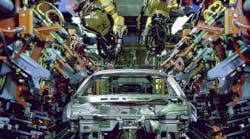In 2015, I took just a quick, three-year break from IndustryWeek. Before I left, I was the technology and innovation editor here, covering those fast early days of what was eventually dubbed the Fourth Industrial Revolution—among other names. Then, the IoT was just starting to make a buzz, 3D printing was about to change the world and wearable technologies seemed like a distant, sci-fi dream.
Outside of that little niche, however, real manufacturing seemed to be on its usual steady course—upticking on the recession rebound, improving continuously, cutting as lean as possible in its global off-shoring/on-shoring dance and clamoring for attention in a post-industrial world.
Now that I'm officially back, I can't find a thing that hasn't changed.
On the technology front, the old line between the world of gadgets and manufacturing has been all but completely erased, snapping the two sides together into a meshed-up riot of capabilities and streamlined, smart operations. It has taken my old back-of-book beat right into the heart of core manufacturing—straight into the everyday workflow of America's best facilities.
Just take a look at our coverage of the 2017 IndustryWeek Best Plants Awards winners, and you will find ample evidence of this—from mixing augmented reality with tractor manufacturing to tech-infused lean operations that boost quality to unprecedented certainty across North America.
And that's only half the picture. The world around manufacturing has changed just as profoundly in my absence.
In 2015, manufacturers and their associations were all out trying desperately to get their stories told, screaming to Washington and the world that this was still a vital industry that could still become vibrant again if it received the attention and policy changes it needed.
Today, manufacturing is suddenly front page news again. We have new policies coming down and new trade deals in the works, we have tariff schemes and infrastructure plans shaping up, all of which at least seem intended to promote American manufacturing.
Put these two sides together, and we seem to be in a pretty good place: We have the technologies we need, we have the ears of the policy-makers, we have the eyes of the world.
Everything is finally in place to stage the long-predicted, desperately needed full-scale U.S. manufacturing comeback. It's all incredibly exciting and filled with new promise and opportunity for just about every market.
But we also have to be realistic about it.
The manufacturing industry has spent decades building elaborate transcontinental manufacturing supply chains that pull materials, parts and labor from every corner of the Earth. At the same time, these exciting new technologies we're using have radically altered the labor requirements of the industry, swapping the demand for traditional low-skill workers for tech-savvy programmers and engineers who can run the machines that do the work instead.
Mix these two points and we have an existential puzzle for the future of the industry, which puts manufacturing at a critical crossroads.
The fact is, manufacturing is not what it used to be. The traditional notion of plants filled with workers, of building a good career on backs and gumption instead of minds and education, is fading rapidly away. On the other side, the economics of both production and sales have become fundamentally intertwined with global sourcing and assembly, if not full off-shore operations.
Transforming all of this into a rebounded pursuit of American manufacturing is going to be a challenge for all of us. It will mean grappling with the full realities of today's market and translating them into a coherent picture of tomorrow's.
With the current trajectory of the economic policies being thrown around, this will mean radical adjustments to all of our five-year plans and playbooks. It will mean recalculations and reconsiderations, it will mean new strategies and new cost analyses.
Bottom line: the potential is there, the potential is great. But realizing it won't be easy.
To me, this all means I have come back at just the right time. I left in the middle of one revolution, and I've returned to find another.
Because these are the times IndustryWeek handles best--finding new strategies and new best practices in a shifting world, pulling together a pool of experts with the insights you need to make it work. That's exactly what this brand and our IW M&T Conference and Expo are all about
And all of it comes down to this: we have exciting, uncertain times ahead of us here. And I'm proud to join the fight with you again.




